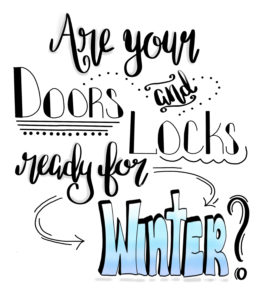 In Kentucky we’ve had a fairly mild autumn so far. In fact, a little less than 48 hours ago we were sitting pretty in the sixties and sunshine.
In Kentucky we’ve had a fairly mild autumn so far. In fact, a little less than 48 hours ago we were sitting pretty in the sixties and sunshine.
It turns out we couldn’t ignore the overused phrase of Jon Snow forever, because it’s true: winter IS coming.
Just like your boat and inground pool, it’s important for people to winterize their doors and hardware. With the cold weather setting in, it’s best to go ahead and get a start on things if you haven’t already and I’m here to tell you how.
Prep Your Door and Lock Hardware for Winter
There are many minor changes you can make that will set you up for a winter with a few less worries, especially when it comes to doors and hardware.
Dirt and Debris
When you think of winter, you probably don’t think about how dirt and debris might be one of the causes of your winter woes. Unfortunately, dirt and debris can cause a lot of problems when it comes to door and lock hardware, but thankfully, it’s an easy fix.
When dirt and debris builds up in your strike cavities, it can cause your doors not to latch properly. If your doors aren’t latched properly, you inadvertently let in cold air from the outdoors which, in turn, will raise your heating bill.
There’s also the concern about moisture leaking in from the outside. Unwanted moisture can do a lot of damage and over time can actually be something that causes you to have to replace your door and lock hardware.
Check Your Weather Stripping
Another key to winterizing your door and lock hardware for the season is weather stripping. It’s simple, effective and inexpensive. It will protect your hardware from cold rain and snow and will keep moisture away from the interior of your building.
If you have an issue with your weather stripping being worn down, you’ll want to replace it as soon as possible. Faulty weather stripping can lead to a plethora of problems by letting cold air seep in. If it’s been worn down enough it will eventually let moisture in as well.
When you keep weather stripping in place your door and lock hardware stay in shape much longer.
Ice, Ice, Lawsuit
I hate to be the bearer of bad news (if you weren’t aware of what I’m about to explain) but ice anywhere on your property can lead to slip hazards.
Slip hazards can lead to broken bones and angry customers and angry customers can also lead to lawsuits.
Obviously your first concern is the safety of your patrons, so be sure you check for slip hazards on a regular basis. While you can’t always keep ice from forming, it’s important to try to stay ahead of the game by properly warning people if you’re aware of a slip hazard.
We suggest you survey your property prior the drop intemps to see of any areas where slip hazards might form. Once you’ve identified the areas, see if you can point out the root of the problem. It might be cracked weather stripping or a debris-filled strike causing your door not to latch and letting moisture leak inside
Once you know what the issue is, you might be able to stop the problem before it starts.
If you have more questions about how to prepare your doors and locks for winter, leave us a comment in the comment boxes down below. If that’s not your style and you’d rather contact us directly you can click here and contact us.
We’d love to hear from you!
